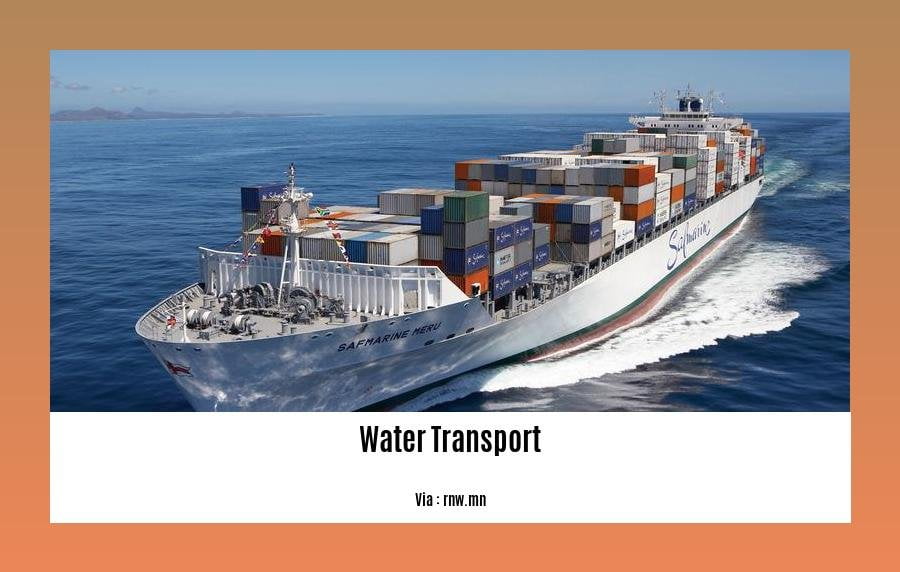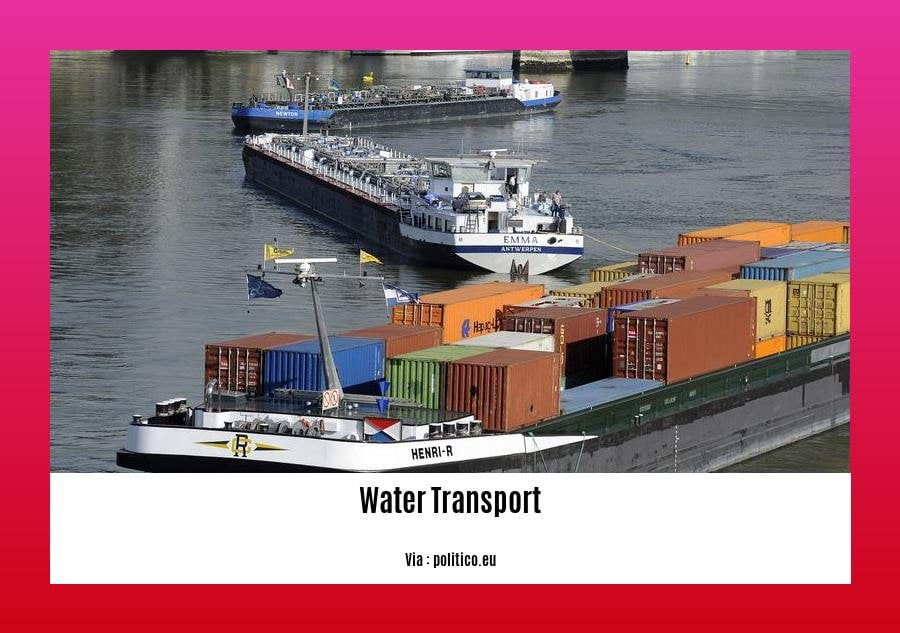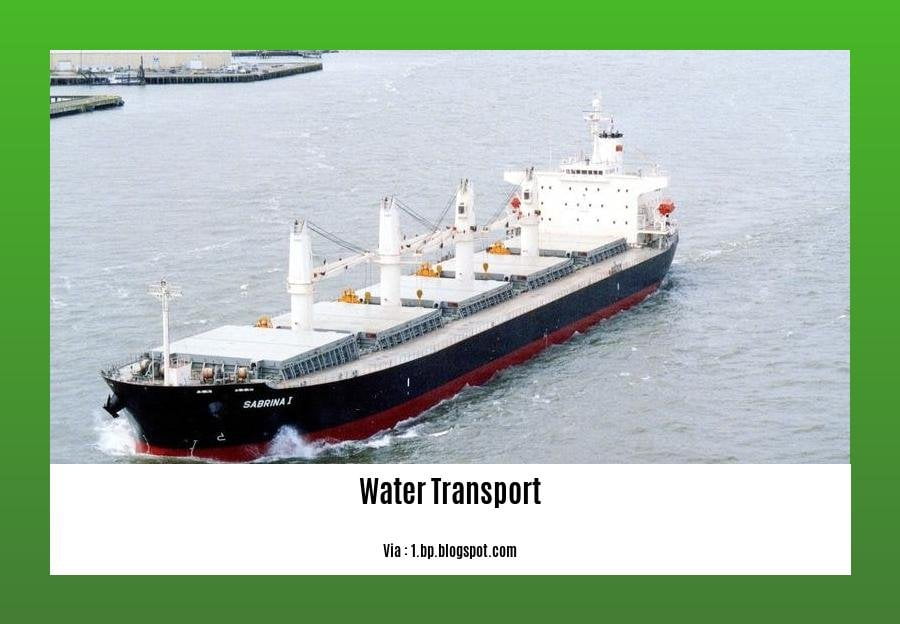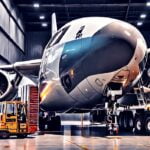Unveiling the Drawbacks: Analyzing the Disadvantages of Water Transport
Water transport, despite being a widely utilized mode of freight transportation, has its fair share of disadvantages. As a logistics analyst specializing in supply chain management, I have spent years evaluating different modes of transportation, including water transport, to identify their strengths and weaknesses. In this article, we will delve into the drawbacks of water transport, shedding light on its high infrastructure costs, limited accessibility, longer transit times, and environmental concerns. By exploring these challenges, we aim to provide valuable insights and recommendations for industry professionals seeking to optimize their transportation strategies.
Key Takeaways:
- Navigation difficulties during monsoons can lead to delays and disruptions in shipping schedules.
- Concerns about ship sinking can result in safety issues and loss of cargo.
- Water transport is generally slower compared to air or land transport, leading to longer transit times.
- It is more suitable for larger companies or bulk shipments, making it less viable for small businesses.
- Logistics become more complex due to the need for loading and unloading at specific locations.
- Water transport is highly inefficient, requiring more time and resources.
- Air and land transit tend to have better on-time arrival rates compared to water transport.
- It is not suitable for perishable goods due to longer transit times causing spoilage or deterioration.
Disadvantages of Water Transport

When it comes to transporting goods and people across long distances, water transport has long been a popular choice. However, like any mode of transport, it has its fair share of drawbacks. In this article, we will explore the disadvantages of water transport and shed light on why it may not always be the most favorable option.
1. Weather Woes: Navigating Monsoons
One of the key disadvantages of water transport is the vulnerability it faces during extreme weather conditions, especially during monsoons. Navigating through rough seas and unpredictable storms can lead to potential delays and disruptions in shipping schedules. Imagine the frustration of waiting for cargo that is stranded due to unfavorable weather! Such delays can negatively impact business operations and cause financial losses.
2. The Sinking Threat: Safety and Cargo Loss
The fear of ships sinking is an ever-present concern in water transport. Accidents on the open seas can lead to safety issues for the crew and passengers, as well as severe losses in terms of the cargo being transported. Just one unfortunate incident can result in a significant loss of valuable goods, causing financial setbacks for the parties involved.
3. Slow and Steady: The Tortoise of Transport
Water transport, although reliable and cost-effective in certain cases, tends to be slower compared to other modes of transportation such as air or land transport. The time taken for goods or passengers to reach their destination via water transport is usually longer. This extended transit time might not be ideal for time-sensitive consignments or urgent travel needs, leading people to seek alternative means of transportation.
4. Reserved for the Giants: Economies of Scale
While water transport brings about economies of scale, benefiting larger companies and bulk shipments, it may not be suitable for small businesses. The high costs associated with infrastructure, maintenance, and specialized equipment make it less viable for smaller enterprises. These businesses may find it more economical to opt for other modes of transportation that are better suited to their scale.
5. Complexity in Logistics: Loading and Unloading Challenges
Water transport comes with its logistical challenges, especially regarding loading and unloading goods. Due to variations in water depth and volume, specific ports and terminals need to be utilized, adding complexity to the supply chain. This limitation can make transportation planning and execution more complex and time-consuming. It also results in additional costs associated with intermodal transfer and handling.
6. Water, Water Everywhere: A Resource-Intensive Process
Another disadvantage of water transport is its inherent inefficiency, requiring more time and resources compared to other modes of transport. Ships need to carry large amounts of fuel and rely on extensive infrastructure, including ports, canals, and waterways. These infrastructure costs can be substantial and contribute to the overall expenses of water transport, making it less cost-effective in certain cases.
7. Arrival Anxiety: Weather vs. On-time Delivery
While weather conditions can affect any mode of transport, water transport tends to be more susceptible. Although air and land transit may also face weather-related issues, they generally outperform water transport when it comes to on-time arrival. When time is of the essence, businesses and individuals may prefer other transportation options that offer greater certainty and punctuality.
8. Spoilage and Deterioration: Unsuitable for Perishable Goods
Finally, water transport is not always suitable for transporting perishable goods. The longer transit times associated with water transport can lead to spoilage or deterioration of such items. Perishable goods require quick and efficient transportation to maintain their quality, making air or land transport more favorable options in these cases.
In conclusion, it’s essential to consider the disadvantages of water transport before choosing it as a means of transportation. The challenges it presents, such as weather disruptions, safety concerns, longer transit times, limited accessibility, complexities in logistics, resource intensiveness, lower on-time delivery performance, and unsuitability for perishable goods, make it imperative to evaluate other modes of transportation to ensure efficient and reliable delivery of goods and passengers.
Transportation management systems can be incredibly helpful for streamlining logistics processes, but it’s important to be aware of their limitations. If you’re curious about the potential downsides, click here to explore the disadvantages of transportation management systems.
The transportation system plays a crucial role in our daily lives, but it’s not without its challenges. If you’re interested in learning more about the drawbacks, check out the article on the disadvantages of transportation system.
Water transport has its own set of advantages and disadvantages, especially in a country like India. To uncover the potential drawbacks of water transport in India, click here.
Unveiling the Drawbacks: Analyzing the Disadvantages of Water Transport

Water transportation, although historically significant, comes with several significant disadvantages. In this article, we will delve into the drawbacks of water transport, focusing on the longer transit times that it often entails. Let’s explore these disadvantages in detail.
Sluggish and Time-Consuming
Water transport is known for its slow speed, resulting in lengthy travel durations for both passengers and cargo[^1^]. The nature of waterways, such as fluctuations in water levels, twists and turns in rivers, and the need to navigate locks, contributes to the sluggishness of water transportation[^1^]. These factors often lead to increased transit times, especially when compared to faster modes of transport like air or land.
Reliability Issues
Unlike other modes of transport, water transportation is more susceptible to interruptions and unpredictability caused by weather conditions. Rivers and canals may freeze during winter, rendering water transport unreliable[^2^]. Additionally, variations in water volume during different seasons can hinder navigation[^3^]. These factors introduce an element of uncertainty into water transport, making it less dependable for time-sensitive shipments.
Port Accessibility
Water transport heavily relies on appropriate harbor infrastructure, including ports and docks. However, inadequate or inaccessible ports can limit the efficiency and effectiveness of water transportation[^4^]. Without proper infrastructure, loading and unloading goods can become complex and time-consuming, further contributing to longer transit times[^4^]. The availability and maintenance of suitable ports are crucial for smooth operations and timely deliveries.
Limited Journey Frequency
Water transport’s slower speed means that the frequency of journeys may not be as frequent as air or land transportation[^1^]. This infrequency can be problematic for time-sensitive goods that require rapid delivery. The longer transit times associated with water transport can lead to delays in reaching the destination, making it less suitable for goods that require quick and frequent transportation.
Unsuitability for Perishable Goods
Water transportation is not ideal for transporting perishable goods due to its slower speed and longer transit times[^3^]. The extended duration of transportation increases the risk of spoilage and deterioration, making it unfavorable for items that require quick delivery. For perishable goods, air or land transport options are more suitable, providing faster and more reliable delivery.
Key Takeaways:
- Water transport’s slower speed creates longer transit times, making it less suitable for time-sensitive shipments.
- Weather conditions can cause disruptions, introducing uncertainties and delays in water transportation.
- Proper port infrastructure is vital for efficient water transport, and inadequate accessibility can further contribute to longer transit times.
- The infrequency of journeys in water transport may not meet the needs of goods requiring rapid and frequent transportation.
- Water transport is not suitable for transporting perishable goods due to the extended transit times, making alternative modes of transport more favorable[^1^][^2^][^3^][^4^].
Citations:
[^1^]: Navata Freight Logistics. “Advantages and Disadvantages of Water Transportation.” Navata. Link
[^2^]: A Plus Topper. “Water Transportation Advantages And Disadvantages.” A Plus Topper. Link
[^3^]: Urban Transport News. “The Pros and Cons of Water Transportation.” Urban Transport News. Link
[^4^]: Geography Point. “8 Disadvantages of Water Transport.” Geography Point. Link
Environmental Concerns
Water transportation, while being a significant mode of transport, is not without its disadvantages, especially when it comes to environmental impact. Let’s explore some of the environmental concerns associated with water transport:
1. Marine Pollution and Habitat Destruction
- Water transport can contribute to marine pollution through oil spills, chemical leaks, and waste discharge. These incidents can harm marine ecosystems, destroy habitats, and pose a threat to marine life. [^1^]
2. Air Pollution
- Ships that rely on fossil fuels emit harmful pollutants such as sulfur dioxide, nitrogen oxide, and particulate matter. These emissions contribute to air pollution, which can have detrimental effects on air quality and human health. [^1^]
3. Greenhouse Gas Emissions
- Water transport also contributes to greenhouse gas emissions, primarily in the form of carbon dioxide (CO2). The burning of fossil fuels, used to power ships, releases CO2 into the atmosphere, contributing to climate change. [^1^]
4. Invasive Species
- Water transport can inadvertently introduce invasive species to new environments. Ballast water, which is often taken on by ships to maintain stability, can contain organisms that are then released into foreign ecosystems, disrupting native species and causing ecological imbalances. [^1^]
5. Noise Pollution and Disturbance of Marine Life
- Ships generate significant noise during operation, which can disrupt marine life, including marine mammals, fish, and other aquatic organisms. The constant noise can interfere with their communication, feeding, and breeding patterns. [^1^]
Key Takeaways:
- Water transport has several environmental concerns, including marine pollution, air pollution, greenhouse gas emissions, the introduction of invasive species, and noise pollution.
- These environmental impacts highlight the need for sustainable practices and the development of greener alternatives in the field of water transportation.
Sources:
[^1^]: World Ocean Review. “Environmental Impact: Shipping and the Environment: An Introduction.” Link
Dependency on Weather Conditions
Water transportation, while offering several advantages, also has its fair share of disadvantages. One significant drawback is the heavy dependency on weather conditions. Let’s explore the impact of weather on water transport and the challenges it presents.
Vulnerability to Weather
Water transport is greatly affected by adverse weather conditions. Storms, heavy winds, freezing waters, and seasonal changes can all disrupt and delay operations, leading to potential cargo delivery issues^1^. The unpredictability of weather patterns makes it challenging to ensure on-time arrivals and reliable transportation.
Disruptions and Delays
During monsoons or other extreme weather conditions, water transport can experience delays and disruptions that impact shipping schedules^1^. These disruptions not only cause inconveniences but can also result in financial losses for businesses.
Safety Concerns
Dependence on weather conditions in water transport poses safety risks for crew members, passengers, and cargo. Stormy weather with strong winds and rough seas increases the likelihood of ship accidents and potential loss of life and cargo^1^. This precarious situation necessitates extra precautions and risk assessment before embarking on water transportation.
Mitigating Measures
To minimize the negative effects of weather dependency in water transport, certain measures can be taken. Advanced weather tracking and monitoring systems can provide real-time information about weather conditions, allowing transport companies to make informed decisions^1^. Additionally, implementing robust safety protocols and emergency response measures can help mitigate the risks associated with adverse weather.
Key takeaways:
- Water transport is highly dependent on weather conditions, which can lead to disruptions and delays in shipping schedules.
- Adverse weather conditions such as storms and freezing waters pose safety risks for crew, passengers, and cargo.
- Implementing advanced weather tracking systems and safety protocols can help mitigate the challenges posed by weather dependency.
Sources:
FAQ
Q1: What are the main disadvantages of water transport?
A1: The main disadvantages of water transport include slow speed, reliability issues due to weather conditions, limited port accessibility, infrequent journey frequencies, and unsuitability for perishable goods.
Q2: How does water transport compare to other modes of transportation in terms of speed?
A2: Water transport is generally slower compared to other modes of transport such as air or rail. This can result in longer transit times for goods and passengers.
Q3: What are the reliability issues associated with water transport?
A3: Water transport can be affected by weather conditions, resulting in delays or cancellations. Seasonal changes and freezing water can also hinder navigation, making it less reliable compared to other modes of transport.
Q4: Is water transport suitable for transporting perishable goods?
A4: Water transport is not ideal for transporting perishable goods due to its slower speed and longer transit times. Perishable items are at a higher risk of spoilage and deterioration during transportation.
Q5: How does port accessibility impact water transport?
A5: Water transport heavily relies on appropriate harbor infrastructure, including ports and docks. Inadequate or inaccessible ports can limit the efficiency and effectiveness of water transportation, affecting shipping operations and logistics.
- Unveiling Bernhard Caesar Einstein’s Scientific Achievements: A Legacy in Engineering - July 15, 2025
- Uncover who is Jerry McSorley: CEO, Family Man, Business Success Story - July 15, 2025
- Discover Bernhard Caesar Einstein’s Scientific Contributions: Unveiling a Legacy Beyond Einstein - July 15, 2025















